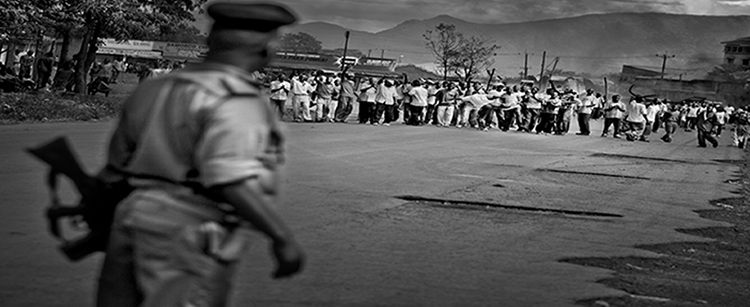By Kwamchetsi Makokha
Your neighbour is unlikely to kill you over the 2017 elections, but the police will surely beat you into accepting the poll results.
Heading into the August 2017 elections, many leading voices have rightly warned about the likelihood of politically-motivated violence but few have gone as far as explaining its possible causes. Over the years, the State has deployed violence to settle political competition, but it is always perfumed and presented as ethnic or land-based conflicts ignited by political incitement and hate speech.
The myth of neighbours turning on each other in 2007/8 is a practised lie that has hidden a disturbing truth about the post-election violence: the violence was either directly caused by the State, or sponsored, financed and winked upon by the State. Modern Kenyan folklore has evolved new powerful myths about the post-2007 election violence, but none more potent or false than the fiction about neighbour turning against neighbour.
Survivors of the fire at the Kenya Assemblies of God Church in Kiambaa, Eldoret, in which 35 souls were lost, have vivid recollections of how Kipleting Chamalan rushed to their rescue.
Chamalan’s neighbours saved him from conviction when he was charged with murder. Numerous victims of the post-election violence acknowledge that their neighbours warned them of impending danger, sometimes hid them for a few days, and helped them to flee to safety. Are these the same neighbours who turned on one another?
Kibera and Mathare in Nairobi as well as Kisumu erupted into violence because of police attempts to ring in residents to prevent them from volunteering for public demonstrations. One police officer, Edward Kirui, was later acquitted of murder for shooting a protestor in Kisumu’s Obunga area. Violence in Nakuru and Naivasha occurred with police blessings.
Police involvement in illegal electoral activity on the one hand, and indifference to law and order on the other, encourages the consequent criminality evident in rape, pillage and plunder that complete the mosaic of anarchy used to excuse State helplessness.
Political leaders who control the State secure police participation in politically motivated violence by compromising them through criminal activity as well as sharing power with them by allowing impunity for crime. The violent and illegal brutality meted out on protestors picketing against the Independent Electoral and Boundaries Commission fits within this pattern.
Recall that two years before the 2007 election, the police began a merciless crackdown on the Mungiki militia group, executing thousands of Kikuyu youth who had taken to brutal methods of establishing the militia as an alternative force. The UN Special Rapporteur for Extrajudicial, Summary and Arbitrary Executions indicted the police for running a campaign of murder and maiming. In counterpoint, another militia group was allowed to breed and thrive on the edge of Mt Elgon on the Kenyan border with Uganda. The Sabaot Land Defence Force operated with impunity, running the police and the provincial administration out of the district as they cut off people’s ears and padlocking the mouths of perceived traitors between 2006 and 2008.
The trigger for the election violence in 2007 was not the burning of the church in Kiambaa. It was a seemingly innocuous action in Nyatike, Migori, where two Administration Police officers deployed as election agents for President Mwai Kibaki’s Party of National Unity were rounded on by a mob and lynched. Head of the public service Francis Muthaura explained to the Commission of Inquiry into the Post-Election Violence that the police deployment was justified by the area’s hostility to the government. When the count was in, police were responsible for 405 of the deaths recorded by the Commission. Additionally, police shootings injured 557 people who did not die. It is not a stretch of the imagination to ascribe deaths caused by militia groups operating with law enforcement protection to the police.
Given that the police were directly or indirectly responsible for a majority of the deaths during the post-election violence, their role making the 2017 election violent comes into sharp relief.
The relief in the police service when former Commissioner of Police Hussein Ali’s crimes against humanity charges were not confirmed at the International Criminal Court was palpable, but it was accompanied by subtle demands for insurance. Having divested itself of operational independence and shirked any pretence at political impartiality, the police service is firmly shackled to the ethnic protection rackets that run the state.
Over the past year, the police have actively rejected constitutionally guaranteed operational independence and successfully requested to be placed under the political wing of the presidency. The National Police Service Act has been amended to give the President power to nominate and appoint the Inspector General without the public scrutiny previously prescribed by the Constitution.
A survey of ethnic diversity in the public service in 2011 found that over 60 per cent of the police officers – both regular and administration – were from two groups: the Kalenjin and the Kikuyu.
This coincides with the fact that the current administration is a Kikuyu-Kalenjin coalition. Six subsequent recruitments have factored ethnic diversity into the distribution of slots, but since that data is not public, important questions remain. Promotion in the police service is based on seniority and experience, which means that even the fairest promotional policy will still produce a disproportionate Kalenjin-Kikuyu majority in the command. The rejection of constitutional independence for the police must be seen within the context of the service’s ethnic composition – especially the command – and how it can potentially be deployed for violence.
Noteworthy but unremarked is the fact that between January 2012 and June 2013, the International Crisis Group recorded over 500 dead and 120,000 displaced in election-related violence. A large cache of arms was discovered in Narok in 2012. No accountability has been delivered for these crimes.
Reform of the police service has produced a political monster. Amendments to the law have not only given the President greater control over the police, but also extended executive reach and discretion to use all uniformed services, including the Kenya Prisons Service, the Kenya Forest Rangers, the Kenya Wildlife Service and the National Youth Service.
The Kenya Defence Forces is routinely deployed in the country to deal with emergencies. An indicator of official protection for police crimes is usually evident in the violent inexplicable deaths of prominent individuals that remain uninvestigated and therefore go unpunished. George Saitoti, George Muchai, Jacob Juma are good examples. Public celebrations after the failure of all efforts to seek accountability for the post-election violence, including the collapse of crimes against humanity cases at the ICC, betrays the culpability of the state and those who control it in the crimes committed. Worse, it opens the door to future crimes that will likely go unpunished.
Recent heavy investment in police equipment – tanks, water cannon trucks, truncheons and shields — appears to be deliberately mismatched with the country’s security priorities to tackle terrorism which deploys technology, social media and propaganda. Perhaps it is not the terrorists that are the enemies of the state – it is the people who will dare to stand up to the stand in numbers. Police conduct in anti-IEBC demonstrations is the clearest harbinger of the fire next time.
First Published in The Hague Trials Kenya







